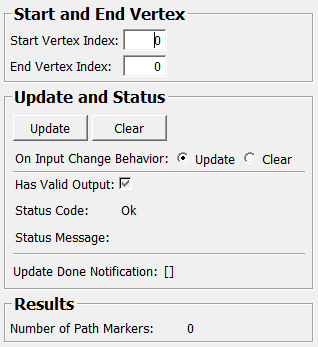CostGraphCheapestPath¶
- MLModule¶
author
package
dll
definition
see also
XMarkerShortestPath,XMarkerListToCostGraph,CostGraphEdgeLengthCostPlugin,CostGraphGenericCostPlugin,CostGraphClosestVertexkeywords
Purpose¶
Runs the Dijkstra algorithm on a given cost graph (boost adjacency list) and tries to find the cheapest path connecting the given start and end vertex.
Usage¶
Connect a XMarkerListToCostGraph or a similar module to inCostGraph and define Start Vertex Index and End Vertex Index. You can use the module CostGraphClosestVertex to determine vertices close to given 3d points.
Details¶
The cost graph is a base object that carries a Boost graph in the form of an adjacency list. The Dijkstra implementation of Boost is then used to find the cheapest path connecting these two vertices in the graph.
Note: we do not use the term shortest path, but cheapest path as the used cost plugins may use other properties than length to compute edge costs.
Tips¶
The performance of this module depends on the number of edges in the input cost graph. Try to reduce the number of edges to speed up the computation. This can be done either by reducing the number of markers in the XMarkerList it was derived from or by choosing appropriate filter criteria in the used cost plugins!
Windows¶
Default Panel¶

Input Fields¶
inCostGraph¶
- name: inCostGraph, type: MLBase¶
Base field containing the cost map in form of a boost graph.
Output Fields¶
outXMarkerList¶
- name: outXMarkerList, type: MLBase¶
XMarkerList representing the found path.
Parameter Fields¶
Field Index¶
|
|
|
|
|
|
|
|
|
|
|
|
|
|
|
Visible Fields¶
Update¶
- name: update, type: Trigger¶
Initiates update of all output field values.
Clear¶
- name: clear, type: Trigger¶
Clears all output field values to a clean initial state.
On Input Change Behavior¶
- name: onInputChangeBehavior, type: Enum, default: Clear, deprecated name: shouldAutoUpdate,shouldUpdateAutomatically¶
Declares how the module should react if a value of an input field changes.
Values:
Title |
Name |
Deprecated Name |
|---|---|---|
Update |
Update |
TRUE |
Clear |
Clear |
FALSE |
Status Code¶
- name: statusCode, type: Enum, persistent: no¶
Reflects module’s status (successful or failed computations) as one of some predefined enumeration values.
Values:
Title |
Name |
|---|---|
Ok |
Ok |
Invalid input object |
Invalid input object |
Invalid input parameter |
Invalid input parameter |
Internal error |
Internal error |
Status Message¶
- name: statusMessage, type: String, persistent: no¶
Gives additional, detailed information about status code as human-readable message.
Has Valid Output¶
- name: hasValidOutput, type: Bool, persistent: no¶
Indicates validity of output field values (success of computation).
[]¶
- name: updateDone, type: Trigger, persistent: no¶
Notifies that an update was performed (Check status interface fields to identify success or failure).
Start Vertex Index¶
- name: inStartVertexIndex, type: Integer, default: 0, minimum: 0¶
Index of the start vertex for path search.
End Vertex Index¶
- name: inEndVertexIndex, type: Integer, default: 0, minimum: 0¶
Index of the end vertex for path search.
Number of Path Markers¶
- name: outNumPathMarkers, type: Integer, persistent: no¶
Number of markers in the found path